Table of Contents
Barbecues on warm evenings are an inevitable part of summer. Unfortunately, there are still people who get goose bumps just thinking about tables full of food. They don’t want to disrupt their progress by mindlessly stuffing themselves with all the food they see on the table. The other extreme are those who stuff everything into their mouths without thinking.
In today’s article we will explain once and for all that barbecues are nothing to be afraid of. We’ll show you how you can easily prepare a meal that is in line with your regular diet and fits perfectly into your diet. And we’ll also give you tips on basic hygiene rules you can follow to avoid any health problems that can be caused by mishandling meat, for instance.
What should you put on your plate when grilling?
Unless you are following a specific diet or eating style, such as low-carb, you should also follow the rules of rational nutrition when grilling. The concept of a healthy plate can help us do this. In simple terms, this means that all macronutrients should appear on our plate in optimal proportions. An ideal barbecue plate could include, for example, 2 slices of meat (about 1-2 palmfuls), a piece of bread or other carbohydrate side dish and a larger portion of vegetables. For a better taste experience, you can add a little dip, which is also a source of fat, as well as a marinade for the meat. Fish with roasted potatoes and grilled vegetables can also work well.
Even on the grill, you can easily conjure up a balanced and healthy meal with an optimal ratio of protein, carbohydrates and fat that will leave you feeling comfortably satisfied. Avoid preparing a full plate of everything available, or being tempted by a 500 g steak that makes you want to roll off to bed rather than enjoy a nice day with friends or family. A complex meal containing all the macronutrients will definitely be a better choice.
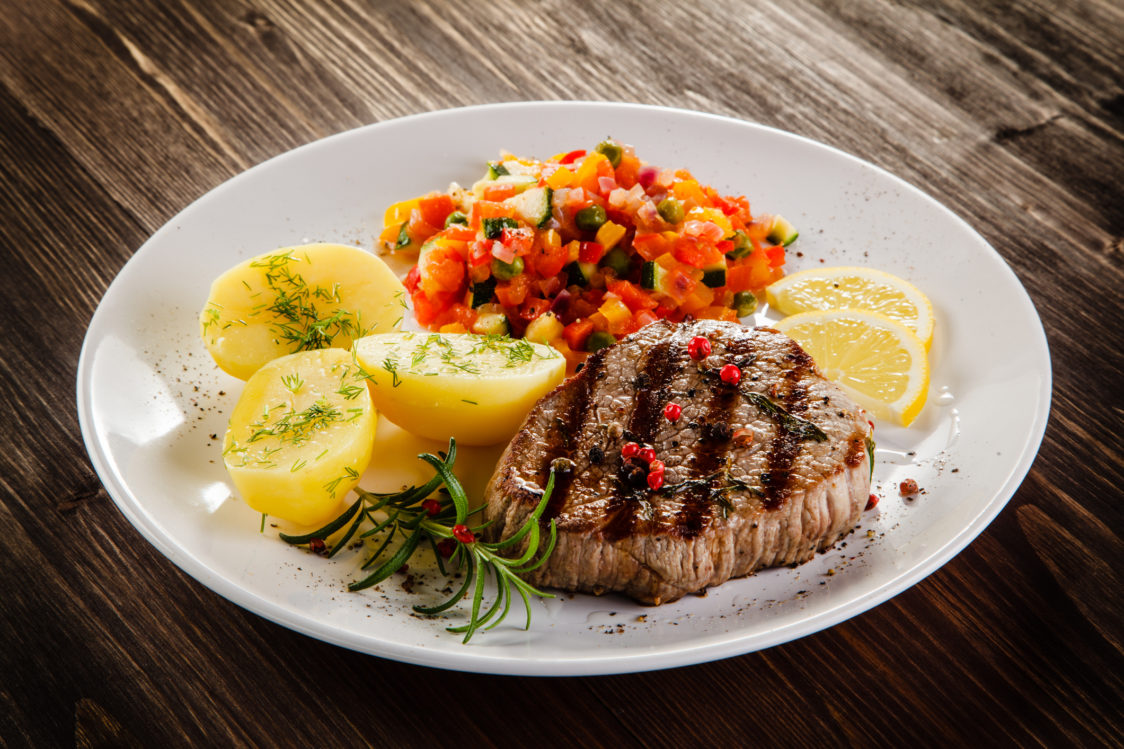
Protein: grilled meat, cheese, tofu and other plant-based alternatives
The basis of every barbecue is undoubtedly protein. Do you know anyone who fires up the grill to roast a handful of vegetables? I certainly don’t. However, different meat, cheese and plant-based alternatives vary in both their nutritional profile and length of grilling. So in the tables below, we’ll break them down more closely so you can get a better idea of which cut is right for you. If you’re trying to lose weight, choose protein sources that have less fat and therefore lower caloric value. So fish or other lean meat or lower-fat cheese are great choices. Conversely, try to avoid fatty meat and cheese or highly processed sausages. These are often low in meat and high in additives.
Keep in mind, however, that the values listed only apply to the raw protein source itself. This does not include the marinade in which you marinate the meat, for example. If you bathe a slice of chicken breast in oil and do not let it drain, the total calorie value can increase significantly. In addition, for each protein source, we include the approximate amount of time the piece should remain on the grill to cook through. Please see these figures as a guide only. The total cooking time will vary depending on the thickness of the meat and the temperature of the grill. It will also vary depending on whether you are grilling directly on the fire or in foil. [6-7]
You might be interested in these products:
Meat – nutritional values per 100g and approximate grilling time
Type of meat | Energy value | Protein | Carbohydrates | Fats | Approximate cooking time on a hot grill |
|---|---|---|---|---|---|
| Chicken breast | 110 kcal | 23g | 0g | 2 g | 4 – 6 minutes each side |
| Boneless and skinless chicken thigh | 116 kcal | 20g | 0g | 4g | 4 – 5 minutes on each side |
| Boneless pork neck (lean) | 170 kcal | 20 g | 0g | 10g | 4 minutes on each side |
| Pork tenderloin (lean) | 102 kcal | 21 g | 0g | 2 g | 4 minutes on each of the 4 sides |
| Beef tenderloin | 125 kcal | 20 g | 0g | 5g | 3 minutes on each side (time depends on the degree of doneness you want) |
| Beef ribs (lightly trimmed of fat) | 166 kcal | 19g | 0g | 10g | 1 hour on a less heated grill |
Fish and seafood – nutritional values per 100g and approximate grilling time
Type of meat | Energy value | Protein | Carbohydrates | Fats | Preparation time on a hot grill |
|---|---|---|---|---|---|
| Trout | 166 kcal | 19g | 0g | 10g | 5 – 6 minutes each side |
| Salmon | 206 kcal | 20g | 0g | 14g | 6 – 8 minutes each side |
| Prawns | 85 kcal | 18 g | 1 g | 1 g | 2 – 3 minutes on both sides |
| Tuna | 137 kcal | 23g | 0g | 5g | 4 – 6 minutes each side |
| Tilapia | 89 kcal | 20 g | 0g | 1 g | approximately 5 minutes each side |
| Mackerel | 130 kcal | 19g | 0g | 6g | 5 – 7 minutes each side |
Cheese and plant-based meat alternatives – nutritional values per 100g and approximate grilling time
Type of side dish | Energy value | Protein | Carbohydrates | Fats | Preparation time on a hot grill |
|---|---|---|---|---|---|
| Tofu (average) | 128 kcal | 12 g | 2 g | 8 g | 2 – 3 minutes on both sides |
| Tempeh (average) | 169 kcal | 20 g | 2 g | 9 g | approximately 4 minutes on each side |
| Seitan (average) | 163 kcal | 18 g | 7 g | 7 g | 4 – 5 minutes on each side |
| Hermelin | 332 kcal | 18 g | 2 g | 28 g | 5 – 10 minutes on each side |
| Low-fat Hermelin | 241 kcal | 21 g | 1 g | 17 g | 5 – 10 minutes on each side |
| Haloumi | 321 kcal | 22 g | 2 g | 25 g | 8 minutes on each side |
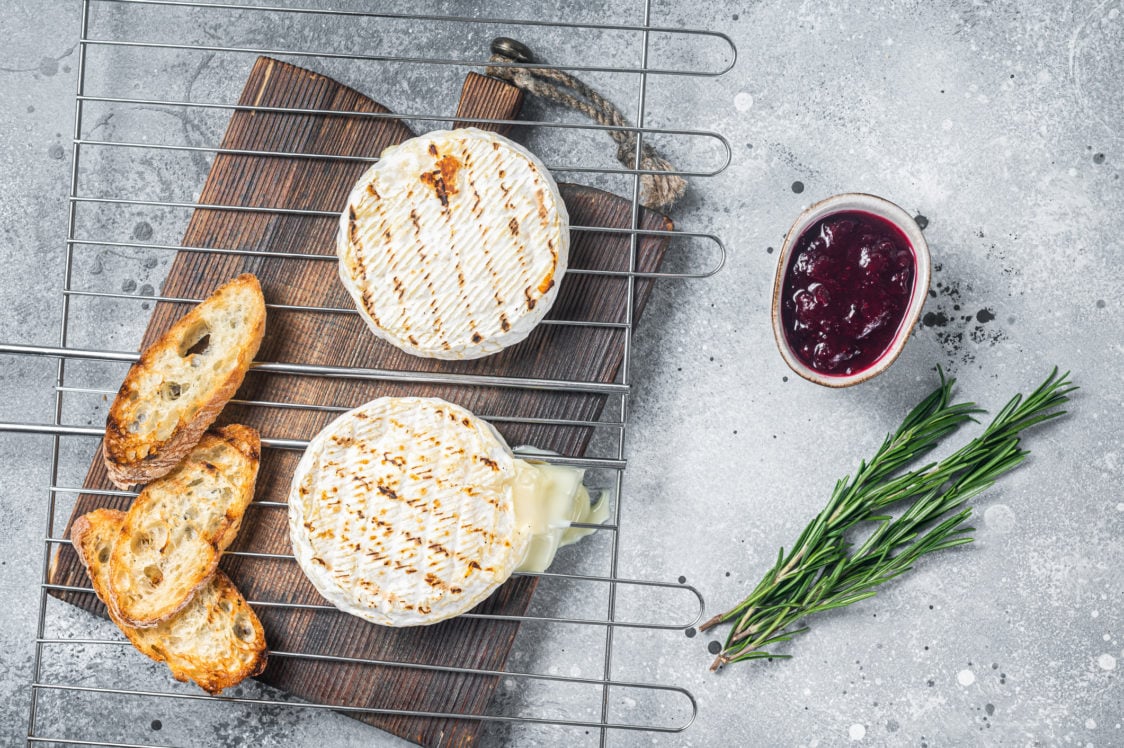
Carbohydrates: bread, potatoes, side salads
In addition to protein, carbohydrates, which serve as a primary source of energy and are a common part of a healthy and balanced diet, should not be missing from your plate. It probably won’t surprise you when a classic baked good appears on the table at a barbecue. But that can get boring at times. So try at least toasting them lightly on the fire. But it’s no bad thing to prepare roast potatoes or sweet potatoes in foil or ash. Chilled salads are also a great choice, as they are refreshing at the same time.
How to prepare a salad for grilled dishes?
- The base can consist of pasta, couscous, bulgur or even millet.
- Fresh or sterilised vegetables must not be missing either.
- For variety, you can add cheese such as Balkan or feta.
- You can also add legumes such as ready-to-eat beans or chickpeas.
- Season with spices, a drop of vinegar or oil, yogurt or sour cream.
- Leave to cool and can be served with grilled meat.
- However, if you want to lighten the meal, you can just reach for a vegetable salad with a light dressing, and then supplement the carbohydrates in other ways.
A carbohydrate side dish should equal about 1-2 handfuls when grilled. For example, if you eat the salad described above, keep in mind that larger pieces of vegetables may be included, so don’t be afraid to load up on a slightly larger helping.
Take inspiration from our recipes:
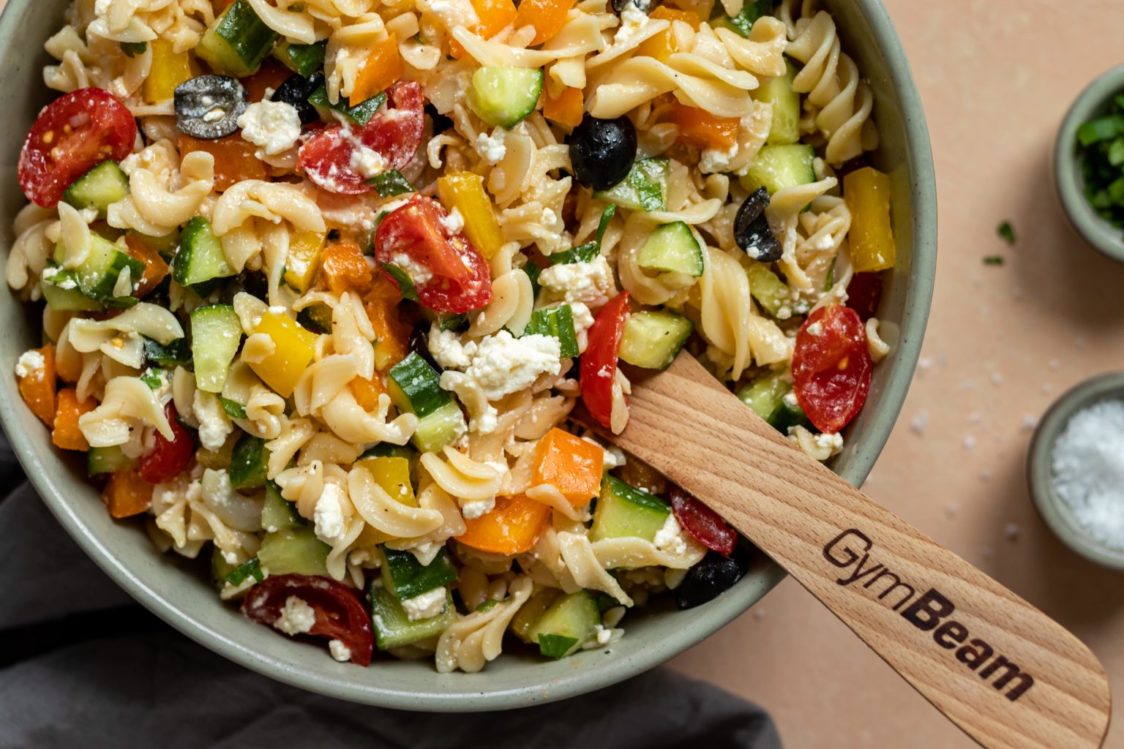
Fats: marinades, dips
In addition to the meat itself, its plant-based alternatives and cheese, other sources of fat can be found at a barbecue in the form of marinades and dips. It is quite common for meat to be marinated in a mixture of oil, garlic and herbs. To some extent, such marinades can help reduce the formation of cancer-causing substances during grilling. The fat from the marinade also helps prevent food from sticking to the grill grate or foil. However, this does not mean that there has to be a lot of it. If you use grill trays, the meat should not be bathed in oil. Let it drain before you put it on the grill, or use paper towels to help soak it up. [1]
You can do the same with marinated vegetables, which you first place on a paper towel, remove excess oil and then grill. An alternative is a yoghurt marinade, which contains significantly less fat and calories. The disadvantage may be that it sticks to the grill more easily.
It’s the same with dips. If you don’t want them to slowly add more calories to your energy intake than the meat itself, reach for those with a yogurt or cottage cheese base. Sour cream dips are also a good choice. You simply need to add herbs, salt, garlic and pepper, or any spices you like, and a delicious homemade dip is on the table. Ketchup or mustard is also a good choice, or our ZERO sauces such as barbecue, honey-mustard, sweet chilli or curry. If you don’t want to increase your intake dramatically due to dips, avoid those with a mayonnaise base.
Vegetables
Vegetables are not only a great source of fibre, but also help you fill your plate with food without increasing the calorie value of the whole meal too much. The types that are most often found at a barbecue are those that are in season. In summer, these are tomatoes, peppers, cucumbers, aubergines and zucchinis, for example. All of these have no more than 40 kcal per 100 g. So you don’t have to worry about the quantity at all and feel free to take a larger serving. Beware only if the grilled vegetables have been marinated in oil, which could cause them to contain more fat. Therefore, try to go for fresh vegetables, or choose pieces from the grill that have been cleaned of most of the oil, for example with a paper napkin.
Fruit
After the barbecue, would you like a sweet treat? This time, forget about dense desserts, which would put even more strain on your digestion. Reach for fruit instead. You can prepare that on the grill too. Especially those with more sugar, such as pineapple and banana, taste great on the fire. This gives them a delicious caramel crust on the surface. You can skewer fruit pieces on a steel skewer and enjoy such desserts. Top it off with a homemade protein ice-cream and you get a balanced dessert that tastes like something from a fancy restaurant.
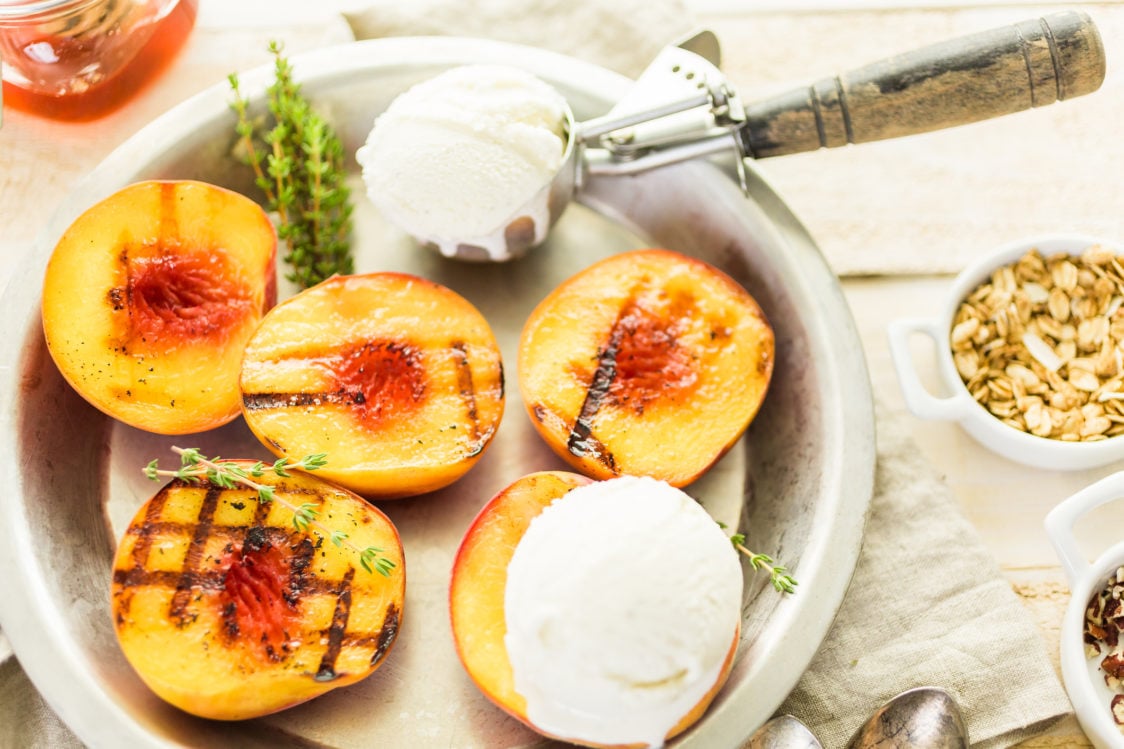
Practical tips on how to reduce calories at a barbecue?
- Before you put the meat on the grill, drain the oil from it to get rid of excess fat. Do not drain it anymore.
- A yoghurt marinade for meat can also work nicely.
- Choose lower-fat protein sources.
- Prepare the meat in foil, where you just need to put a small amount of fat.
- If you’re craving a burger made with fattier meat, feel free to have one if it fits into your overall daily intake. Alternatively, you can just have a smaller serving. Some people suggest that you can, for example, use lettuce leaves instead of bread and so on. However, it is no surprise that lettuce never tastes like bread. Rather than coming up with less tasty alternatives, it’s definitely a better experience to indulge in a smaller portion of the original burger. For example, you can prepare it according to our recipe Juicy Chicken Burger with Avocado and Yoghurt Dressing.
- Do not forget about vegetables and various salads. Again, avoid large amounts of oil-based dressings and marinades.
- Eat cottage cheese dips or ZERO sauces.
- Keep in mind that drinks count too. One 0.5l beer may have the same calories as 200 g of chicken breast, but it will definitely fill you up more quickly. So choose wisely.
These simple tips can help you save calories and build a balanced plate of grilled food. However, if you have a set number of calories you should eat in a day, it’s a good idea to allow for that when grilling. If you know you’re going to have a larger meal in the evening, or have some drink, it’s a good idea to factor this into your intake throughout the day. Therefore, reduce your lunch or breakfast portion or skip an afternoon snack. You won’t go wrong if you walk or cycle to the barbecue. You’ll increase your output during the day and you’ll even enjoy your well-deserved barbecue more after exercising.
How a plate at a barbecue can differ in calories?
To give you a better idea, let’s compare two different plates at a barbecue that may look almost identical in terms of food volume, but are fundamentally different in terms of caloric value (all values are calculated from raw ingredients). Even though the second version may look bigger on the plate, it has almost half the amount of calories. So be cautious when choosing specific grilled items so you don’t unknowingly eat most of your daily calorie allowance in one meal.
Version 1
- 120 g pork neck (marinated in oil, about 10 ml remains on the meat)
- 120 g of Hermelin in foil (lightly coated with oil, approx. 5ml)
- 30 ml mayonnaise and garlic dip
- 100 g baked goods (bread, bread rolls)
Nutritional values: 55 g protein, 49 g carbohydrates, 87 g fat, 4 g fibre, 1207 kcal
Version 2
- 160 g trout grilled in foil (with a 4 g piece of butter)
- ½ (50 g) light Hermelin (lightly brushed with oil, approx. 3 ml)
- 30 ml ZERO SAUCE Barbecue
- vegetable salad with couscous (100 g tomatoes, 50 g peppers, 100 g cucumbers, 40 g couscous, vinegar dressing)
Nutritional values: 48 g protein, 37 g carbohydrates, 32 g fat, 4 g fibre, 636 kcal
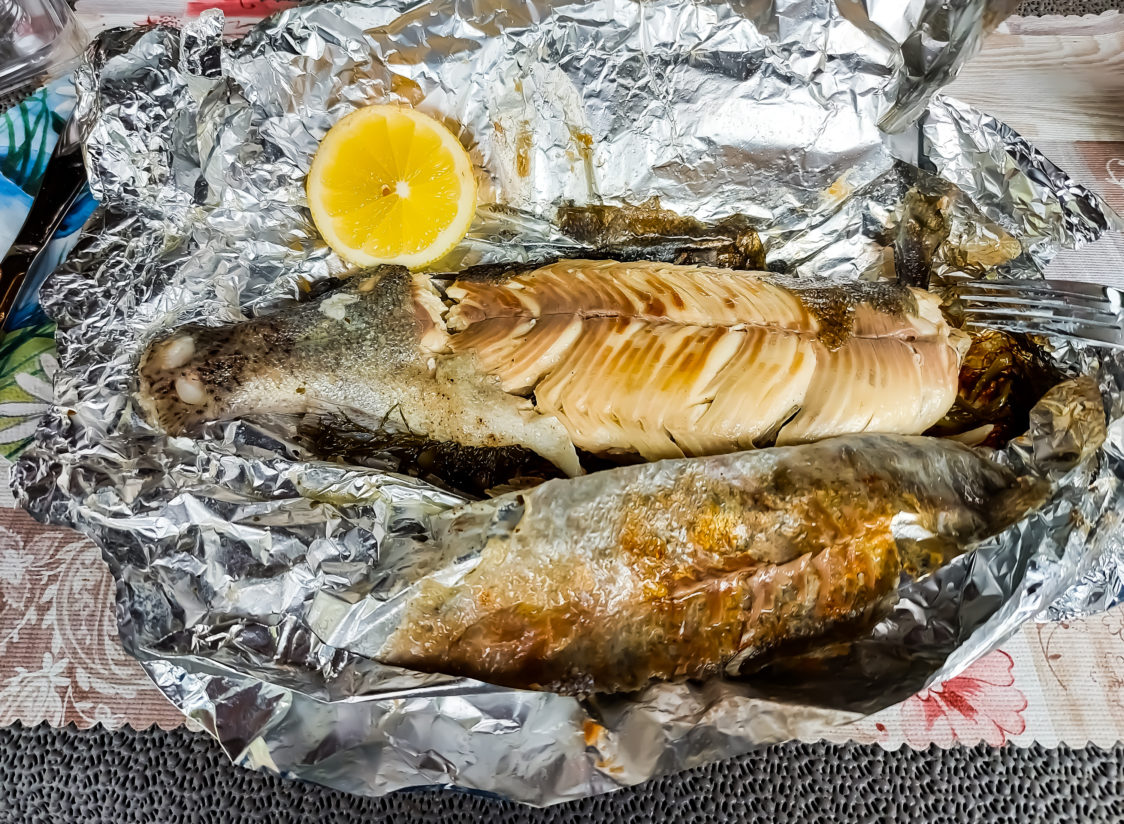
How to grill more healthily and avoid health problems?
Calories and flavours are not the only things you should be concerned about when grilling. More importantly, it’s crucial to focus on proper ingredient handling and overall hygiene habits. These will help you avoid health problems that could arise from poor practices. We have therefore compiled the most important principles you should follow for every barbecue:
- Before and after you handle any ingredients, wash your hands for at least 20 seconds with warm water, ideally with soap.
- Everyone who is dining with you should wash their hands before eating. As hands are often used to touch the food on the table when having a barbecue, stricter hygiene measures should be observed and conditions adapted accordingly.
- Avoid cross-contamination. Do not use the same utensils (knife, cutting board, etc.) to prepare different ingredients such as meat and bread. Similarly, keep these ingredients separate during storage. Our article may help you with this How to Store Food Correctly to Make It Last as Long as Possible.
- When grilling, do not use the same utensils and cutlery for both raw and cooked meat. For example, if you use the same fork to turn raw and cooked meat at the same time, bacteria (e.g. Salmonella) from the raw meat may enter the cooked meat and cause health problems.
- Do not brush the meat with the marinade in which the raw meat was stored in towards the end of grilling. Again, bacteria may be transmitted.
- Use a temperature-stable fat such as canola oil.
- When dining outside, do not leave mayonnaise dips and dairy products in the sun for long periods of time to prevent them from spoiling.
- When lighting fires, use non-toxic firelighters. Do not use petrol or diesel.
- Buy quality meat of which you know the origin. For some types, such as beef, you won’t even need a marinade, just salt and pepper. And if you prefer marinated meat, prepare your own marinade at home, rather than buying marinated meat where you don’t know what it contains and in what condition it has been marinated.
- Place the meat on a hot grill and maintain the temperature. Don’t overcook it on a low heat for too long, so that you don’t end up with a piece of rubbery meat like a shoe sole.
- Always make sure that, for instance, chicken meat is not raw. You can check the temperature with a thermometer. If you don’t have one, cut the pieces at the thickest point and check that they are cooked through before serving. We’ve provided approximate grilling times for each type of meat listed above to help you prepare them.
- Try to eat the meat as soon as possible after cooking so that it does not sit on the table for a long time.
- Keep food on the table covered to prevent insects from settling on it, which can transmit bacteria. Keep baked goods in bags or put a clean cloth over them, salad bowls can be covered with a lid and meat can easily be covered with foil.
- Clean the grill after each grilling session to prepare it for the next meal. [2]
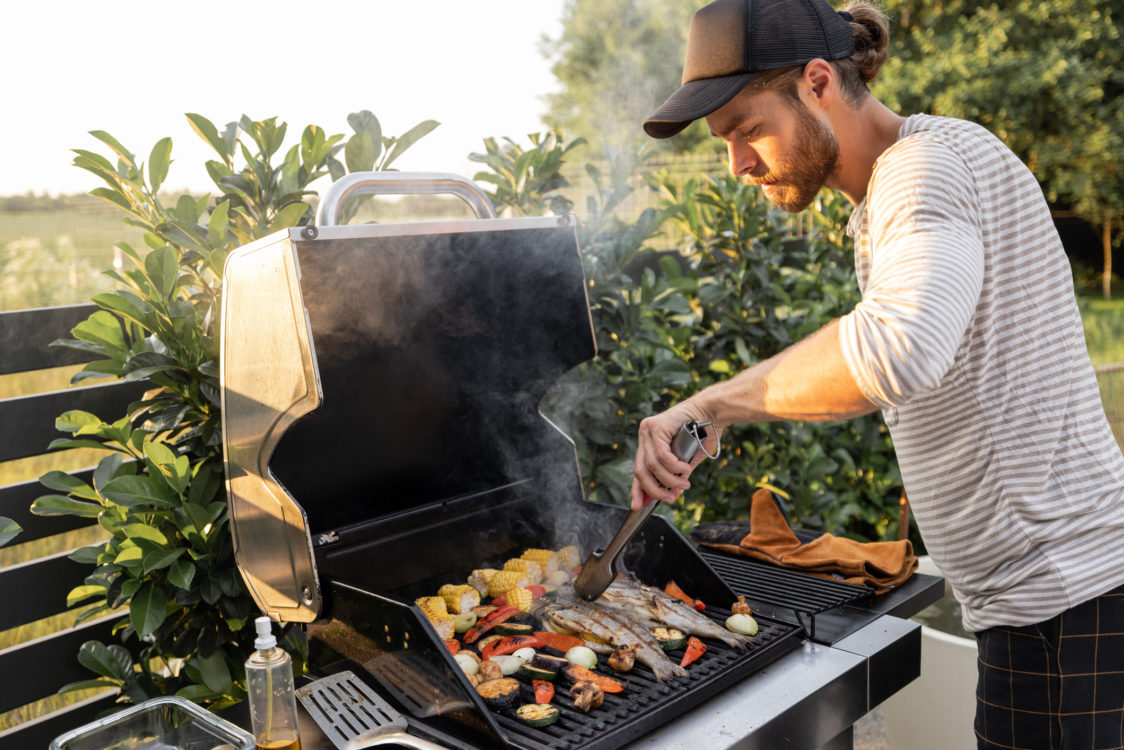
How to reduce the risk of cancer-causing substances?
It is no secret that grilling also produces cancer-causing substances, including HCAs (heterocyclic amines) and PAHs (polycyclic aromatic hydrocarbons). These substances are so-called mutagenic, which means that they can cause changes in DNA, which in turn are associated with a potentially higher risk of developing certain types of cancer (especially of the digestive tract). [1] [3]
- HCA is formed by amino acids, sugar, creatine and creatinine reacting at high temperatures.
- PAHs are formed as the fat and juices from grilled meat drip into the fire, causing smoke. This smoke then contains the PAHs mentioned above, which are deposited on the surface of the meat.
From this point of view, grilling can be one of the least suitable ways of preparing meat. These potentially harmful substances are formed at high temperatures, when the meat is burnt. Grilled bacon, for example, contains the greatest number of carcinogens, followed by pork. [4-5]
How to minimize the production of these substances?
- Therefore, try to prepare leaner cuts and trim off any visible fat before cooking.
- You can also reduce the formation of hazardous substances by using a marinade. A great combination is temperature-stable oil with herbs, garlic and spices.
- You can also reduce the amount of unwanted substances by regularly brushing the meat with marinade (but don’t use the one you had raw meat in, so that bacteria don’t get into your prepared meat).
- Turn the meat over regularly so that it does not burn. Remove any burnt meat from the grill as soon as possible.
- Ideally, keep the meat on the grill for as short a time as possible. The priority is, of course, to cook it through sufficiently.
- Grilling in foil is also a great option.
- Before serving, cut off the black parts and throw in a good serving of vegetables, which are high in antioxidants.
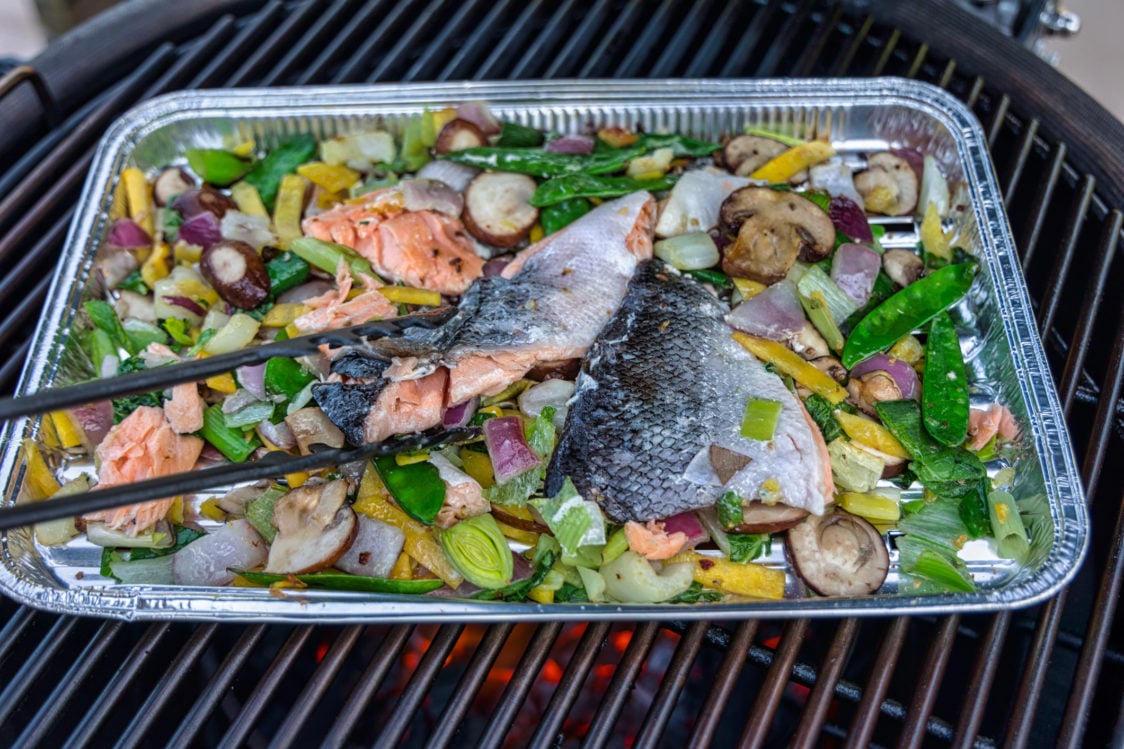
What should you remember?
The occasional barbecue doesn’t have to be a scary thing, both in terms of form and health. In fact, it’s always up to you what choices you make when it comes to food. If you’re watching your figure, try to choose lower-fat sources of protein and supplement with a serving of carbohydrates as well as vegetables. It’s also ideal to avoid liquid calories in the form of sugary sodas and alcohol. You should also keep in mind hygiene guidelines to minimize the risk of food poisoning. You can also reduce the risk of developing unwanted cancer-causing substances. Simply use a marinade and minimize the time spent grilling the meat. Of course, always make sure that chicken and pork in particular are sufficiently cooked through.
Remember that besides the food, the most important thing at a barbecue is the quality time you spend with your loved ones. So don’t stress yourself too much with food and enjoy your time together. And if you have someone amongst your friends who are afraid to go to barbecues so as not to get out of shape, share our article with them.
[1] Marinate Meat for Healthy Grilling? – https://www.webmd.com/cancer/news/20080801/marinate-meat-for-healthy-grilling
[2] Your Guide to Healthy Grilling – https://www.webmd.com/women/safe-grilling
[3] Chemicals in Meat Cooked at High Temperatures and Cancer Risk – https://www.cancer.gov/about-cancer/causes-prevention/risk/diet/cooked-meats-fact-sheet#are-there-ways-to-reduce-hca-and-pah-formation-in-cooked-meats
[4] How to Grill for Lower Cancer Risk in 3 Steps – https://www.aicr.org/news/how-to-grill-for-lower-cancer-risk-in-3-steps/
[5] David W. Layton et al. – Cancer risk of heterocyclic amines in cooked foods: an analysis and implications for research – https://academic.oup.com/carcin/article-abstract/16/1/39/323739?redirectedFrom=fulltext
[6] Databáze složení potravin – https://www.nutridatabaze.cz
[7] Nutrition Data – https://nutritiondata.self.com


Add a comment